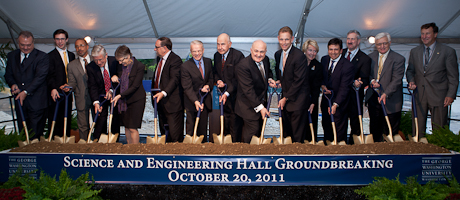With the ceremonial turn of more than a dozen golden shovels in the earth, George Washington President Steven Knapp, university trustees, faculty members, students and GW friends marked the official groundbreaking for the Science and Engineering Hall, a state-of-the-art home for GW’s science and engineering departments.
“To be truly the world-class university that we are every day becoming, we need facilities equal to our world-class faculty,” Dr. Knapp told approximately 500 people gathered under a tent beside the construction site. “To be a powerful institution devoted to making advances in the realm of policy, in today’s world you have to have credibility and power and competence and excellence in science and engineering. This project is absolutely integral to everything we’re trying to achieve as a university.”
The groundbreaking marked the official beginning of what is planned to be a four-year construction process, with anticipated completion by 2015. The building will nearly double the amount of space currently available at GW for science and engineering, including eight floors above grade and two floors below for teaching and laboratory facilities, and four floors below grade for parking. The building will serve faculty and students in GW’s Columbian College of Arts and Sciences and School of Engineering and Applied Science.
Board of Trustees Chair W. Russell Ramsey, B.B.A. '81, said that the Science and Engineering Hall is a part of GW’s vision of joining the ranks of the great universities.
“You’ve all heard me say that the idea of vision without execution is hallucination,” he said. “This is not the beginnings of execution, but the culmination of months and years and in some cases decades of planning and thinking and some really talented, committed people thinking about the value of science and engineering.”
Dr. Knapp acknowledged the work of a diverse team of players who have worked to make the Science and Engineering Hall a reality. That group includes the university Faculty Senate, which in 2004 passed a resolution making the planning and construction of a new science facility the highest priority facilities project for the Foggy Bottom Campus.
Dr. Knapp also acknowledged Donald Lehman, George Gamow Professor Emeritus of Theoretical Physics and former executive vice president for academic affairs, for his dedication to the project, as well as the GW Board of Trustees for its careful planning. The board devised a plan that will use revenue from The Avenue—the new mixed-use development on the site of the old GW Hospital—to partially fund the Science and Engineering Hall construction project. Students from Campaign GW and Foggy Bottom neighbors who championed the zoning case for the new building were also recognized.
University Trustee Nelson Carbonell Jr., B.S. ’85, vice chairman of the board, SEAS alumnus, and chair of a special committee on the Science and Engineering Hall, described how he took fellow board members on walking tours of the university’s existing science facilities to make the case for the new building.
“We toured Corcoran Hall and we toured Tompkins Hall, and we went to the basement of Tompkins Hall,” he said, to knowing laughter from the audience. “And the one thing that connects generations of GW engineers and scientists is that we studied in really crummy facilities. And it made us scrappy! ...We need to keep that scrappy feeling. GW scientists and engineers can do a lot with a little. But just imagine what we can do with a lot.”
Columbian College Dean Peg Barratt said she and the college’s faculty members are excited for the opportunities the new hall will provide. “In Columbian College of Arts and Sciences, we do great science, but this building will be transformative. We’re very excited to be at this stage.”
David Dolling, dean of SEAS, said he felt close to speechless as he contemplated that the groundbreaking had finally arrived. “This is a wonderful day. That’s all I can say,” he said, before calling members of the SEAS faculty and administration who had been instrumental in the planning process to take shovels and turn the ground. “SEAS group, show them how shovels are used!”
Chairman of the Department of Mechanical and Aerospace Engineering Michael Plesniak said he is thrilled at the prospect of having all the university’s undergraduate science labs and teaching spaces under one roof. “There’s a great deal of excitement and synergy that it will bring,” he said.
There are three major phases for construction of the Science and Engineering Hall: excavation, sheeting and shoring from late 2011 to mid-2012; construction of foundations to grade from mid-2012 to early 2013; and construction above grade to completion from early 2013 to late 2014. Building occupancy is expected by January 2015.


